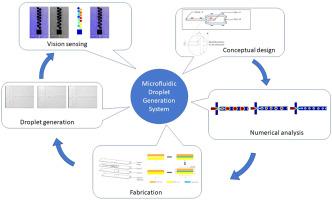Sensors and Actuators A: Physical ( IF 4.1 ) Pub Date : 2021-08-26 , DOI: 10.1016/j.sna.2021.113047 Samith Hettiarachchi 1 , Gehan Melroy 1 , Amith Mudugamuwa 1 , Peshan Sampath 1 , Charith Premachandra 2 , Ranjith Amarasinghe 1, 2 , Van Dau 3

|
Lab on a Chip (LOC) devices minimize, integrate, automate, and parallelize laboratory functions such as mixing, separation, and incubation on a single chip. Droplet generation is one key aspect in LOC devices which allows to conduct various chemical and biochemical assays enabling biological cell studies, high throughput drug development, and diagnostic screenings. This paper presents, modelling, simulation, and experimentation of an active droplet generator that is widely used in LOC devices. The model geometry used in this study was based on a flow focusing method of droplet generation. Droplet generation from the numerical simulations was observed within flow rate ratios ranging from 0.2 to 4 using optimised droplet contraction width of the generator model. Subsequently, a prototype droplet generator was designed and developed from Polymethyl Methacrylate (PMMA) material using a layer-based fabrication method. Based on the experimental setup presented here, the calculated ratios of flow rates obtained for different voltage values have shown that the formation of droplets occur between flow rate ratios of 1.04 and 4.74. In addition, morphological parameters of the droplet images extracted from a digital image processing algorithm show that the mean diameter of the droplets decreases with decreasing flow rate ratios.
中文翻译:

用于芯片实验室设备的具有视觉传感的微流体液滴发生器的设计和开发
芯片实验室 (LOC) 设备在单个芯片上最小化、集成、自动化和并行化实验室功能,例如混合、分离和孵化。液滴生成是 LOC 设备的一个关键方面,它允许进行各种化学和生化分析,从而实现生物细胞研究、高通量药物开发和诊断筛选。本文介绍了广泛用于 LOC 设备的有源液滴发生器的建模、模拟和实验。本研究中使用的模型几何基于液滴生成的流动聚焦方法。使用发生器模型的优化液滴收缩宽度,在 0.2 到 4 的流速比范围内观察到从数值模拟中产生的液滴。随后,原型液滴发生器是使用基于层的制造方法由聚甲基丙烯酸甲酯 (PMMA) 材料设计和开发的。根据此处介绍的实验设置,计算出的不同电压值的流速比表明,液滴的形成发生在 1.04 和 4.74 的流速比之间。此外,从数字图像处理算法中提取的液滴图像的形态参数表明,液滴的平均直径随着流速比的降低而减小。











































 京公网安备 11010802027423号
京公网安备 11010802027423号